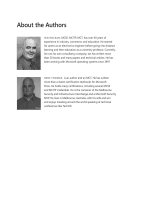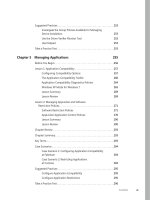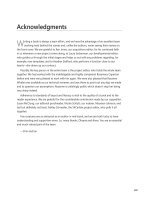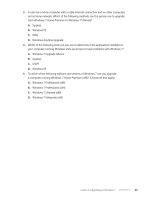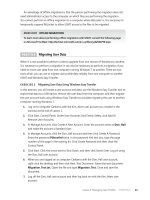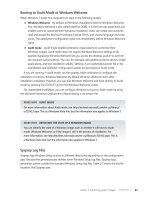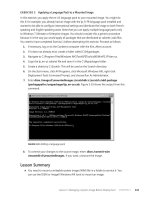Configuring Windows 7 (Training Kit) - Part 15 pot
Bạn đang xem bản rút gọn của tài liệu. Xem và tải ngay bản đầy đủ của tài liệu tại đây (273.9 KB, 10 trang )
CHAPTER 3 113
CHAPTER 3
Deploying System Images
T
his chapter discusses the management, manipulation, and deployment of system
images. You deploy an image when you install it on one or more target computers.
It looks at how you mount a system image so it can be updated and altered, how you
then commit these changes to the original image, and how you distribute that image to
a number—often a large number—of client computers. In the context of system images,
you mount an image by expanding it into a folder so you can obtain information about it
and add or remove features such as drivers, updates, and language packs.
Microsoft provides a range of tools for image manipulation and deployment, some of
which are specific to Windows 7 images, whereas others are more general. Some tools
manipulate images, others deploy them, and some tools do both. It is your job as a network
administrator to choose the best tools for your current and future needs and configure
them so that they work efficiently and go on working efficiently.
If your users are sitting at computers with operating systems, drivers, and applications
that are up to date and as invulnerable as you can make them to Internet (and intranet)
attacks they will be less unhappy. If you can bring one computer or 100 computers into full
operation quickly, efficiently, and without error, then your boss will be less unhappy. (We all
know, of course, that neither users nor bosses are ever happy.)
Exam objectives in this chapter:
n
Prepare a system image for deployment.
n
Deploy a system image.
Lessons in this chapter:
n
Lesson 1: Managing a System Image Before Deployment 116
n
Lesson 2: Deploying System Images 146
1 1 4 CHAPTER 3 Deploying System Images
Before You Begin
To complete the exercises in the practices in this chapter you need to have done the following:
n
Installed the Windows 7 operating system on a stand-alone client PC, as described in
Chapter 1, “Install, Migrate, or Upgrade to Windows 7.” You need Internet access to
complete the exercises.
n
Completed all the practice exercises in Chapter 2, “Configuring System Images.”
In particular, you need to have installed the Windows Automated Installation
Kit (Windows AIK) and deployed an offline image of the Canberra computer on
a bootable virtual hard disk (VHD).
real World
Ian McLean
E
ach of the tools you use for network and system administration has its own set
of features and enables you to perform specific tasks. Where people sometimes
get upset and confused is if there is overlap. For example, you can use Windows
Deployment Services (WDS) or the Microsoft Deployment Toolkit (MDT) 2010 to
deploy Windows 7 images to client computers. However, MDT 2010 allows you to
specify a set of configuration tasks that should be run on a computer after an image
has been deployed to it through WDS, whereas WDS cannot run configuration tasks
on a client after the image has been deployed.
You use ImageX to create an image of a computer running Windows 7 while it is
booted to Windows Preinstallation Environment (Windows PE) and you use the
Deployment Image Servicing and Management (DISM) tool to manipulate that
image after it has been created. However, you can use ImageX or DISM to mount an
image so you can work with it offline.
So, you are entitled to ask, which tool do I use and, more to the point in this book,
what tool will the examination ask about? The simple answer is to use the most
recently introduced tool when there is a choice. For example, ImageX has been
around for some time, whereas DISM was introduced fairly recently; however,
ImageX has new features in the latest edition of the Windows AIK.
Traditionally, examinations ask more questions about new features of an
operatingsystem and new tools that are introduced to carry out tasks on the
new operating system than they do about features that are unchanged from the
previous operating system and tools that, however worthy, have been around for
a while. This is simply a statement of fact and any conclusions you draw from it are
your own.
Before You Begin CHAPTER 3 115
However, as a professional administrator rather than merely an examination candidate,
what tool do you choose to do your job? That’s up to you. My advice is if you’ve been
using DISM frequently in the recent past and have got into the rhythm of typing in
DISM commands, use that tool if you are given the choice. Otherwise, my preferred
tool when I’m mounting an image is ImageX. The commands are shorter (important
when you’re as slow a typist as I am), I find the command completes sooner, and if
something does go wrong, ImageX usually gives a more detailed explanation. That,
however, is only my opinion, with which you are absolutely entitled to disagree.
As a professional, use your best judgment. As an examination candidate, know what
all the tools do, what a tool does that no other tool can do, what a tool does that is
unique to the new operating system or that you haven’t been able to do before, and
what jobs can be done equally well by two or more tools.
Good luck.
1 1 6 CHAPTER 3 Deploying System Images
Lesson 1: Managing a System Image
Before Deployment
Sometimes when you have created a master reference image for deploying to other computers,
you might find that you need to amend it. You night need to add a new driver, change settings,
and support multiple languages. Even a fairly minor change, such as enabling a feature currently
disabled in the image, can generate a considerable workload if it needs to be done after the
image has been distributed to several hundred computers.
Typically, it involves less administrative effort if you make these changes without deploying
the image and recapturing it. If your requirement is to add security updates, then it is
certainly preferable to apply the security patches offline—otherwise, you are deploying an
insecure image. If you service the image offline, you do not need to run the Sysprep tool
and therefore do not need to use a rearm parameter. Finally, you might want to apply an
amended Autounattend.xml file for unattended install or an additional Unattend.xml file that
automates post-installation tasks such as installing mission-critical applications. Unattend.
xml files are discussed in the section entitled “Unattended Servicing Command-Line Options,”
later in this chapter.
This lesson discusses how you use Windows AIK tools such as ImageX and DISM to mount
a system image and how you use DISM to manage the image, insert packages, insert updates,
enable and disable features, manage international settings, manage language packs, and
associate unattend answer files.
After this lesson, you will be able to:
n
Mount an offline image for servicing.
n
Use DISM to manage and manipulate the image.
n
Associate one or more answer files with the image.
n
Commit and unmount the image.
Estimated lesson time: 50 minutes
Using DISM WIM Commands and Mounting an Image
Chapter 2 introduced the Windows 7 DISM command-line tool. DISM enables you to service
offline images, mount and dismount Windows Imaging format (WIM) files, and customize
Windows PE boot images. The DISM tool replaces many of the tools in previous versions
of the Windows AIK, including Package Manager (Pkgmgr.exe), the International Settings
Configuration Tool (Intlcfg.exe), and the Windows PE command-line tool (PEimg.exe).
Microsoft has designed the DISM tool to manage WIM images. Also, DISM is
backward-compatible with Vista tools, such as Pkgmgr.exe, Intlcfg.exe, and PEimg.exe, so
scripts that you developed and tested for Vista should work unamended in Windows 7.
Lesson 1: Managing a System Image Before Deployment CHAPTER 3 117
note BACKWARD COMPATIBILITY
You can install the Windows AIK in Windows 7, including DISM, on Windows Vista
SP1. If you manage Windows 7 and Windows Server 2008 R2 images under Vista, this
backward-compatibility provides full functionality. DISM also works for Windows Vista SP1
and Windows Server 2008 images, but only with limited functionality. You can use all of
DISM’s features for Windows Vista SP1 images that would have worked with Pkgmgr.exe,
Intlcfg.exe, or PEimg.exe. You will get an error message if you use a command-line option
that is not supported for a Vista image.
Chapter 2 also introduced the ImageX tool, which you used to create a WIM image file.
Typically you can use either DISM or Image X to mount WIM files. DISM is the recommended
Windows AIK tool for managing and manipulating offline images. It allows you to install and
configure operating system updates, packages, and drivers on an offline system image. You
can use DISM to modify Windows PE images offline and to change the language, locale,
fonts, and input settings on a Windows image.
The commands that DISM offers for image management depend upon the type of image
you want to manage. You access DISM by clicking All Programs on the Start menu, clicking
Microsoft Windows AIK, right-clicking Deployment Tools Command Prompt, and choosing
Run As Administrator. You might need to click Yes to allow the program to run. Entering
dism in the elevated Deployment Tools Command Prompt window generates a list of DISM
commands. Figure 3-1 shows commands specific to WIM images.
FIGURE 3-1 DISM commands for managing WIM images
For example, to get information about Myimage.wim, the WIM file that you created in
Chapter 2 and installed on a bootable VHD with the drive letter W:, you enter the following
command:
dism /get-wiminfo /wimfile:w:\myimage.wim
1 1 8 CHAPTER 3 Deploying System Images
The output from this command is shown in Figure 3-2. If this command cannot find the
image, open Computer Management and attach the VHD. It is the file Myvhd.vhd in the VHDs
folder. If you did not create a VHD, you should find the same file in the D:\Images folder (or
whatever destination you specified in the practice session in Chapter 2). If the file Myimages.
wim does not exist at all, copy the file Install.wim from your installation DVD-ROM to
D:\Images and use it instead.
FIGURE 3-2 Using the /Get-WimInfo and /Wimfile switches
However, if you want more detailed information about the image, you can use the ImageX
tool as follows:
imagex /info w:\myimage.wim
Part of the output from this command is shown in Figure 3-3. The file contains only one
image with the index number 1. (If you are using the Install.wim image, you need to discover
the index number for the Windows 7 Ultimate image—typically 5.)
FIGURE 3-3 Detailed information about a WIM image
Lesson 1: Managing a System Image Before Deployment CHAPTER 3 119
Mounting WIM Images
If you want to manage an image, you first need to mount it. To mount the W:\Myimage.wim
image on (for example) the C:\MountedImages folder, you enter the following command in
the elevated Deployment Tools command prompt:
dism /mount-wim /wimfile:w:\myimage.wim /index:1 /mountdir:c:\mymountedimages
The /index flag in this command indicates the image that you want to mount. You can
have several images (for example, several editions of Windows 7) within a single WIM file.
You can add the /readonly flag to this command if you want the image to be read-only.
Alternatively, you can use the ImageX tool from the same console by entering the following
command:
imagex /mountrw w:\myimage.wim 1 c:\mountedimages
If you want to try out both commands, you need to create and use another destination
folder for the second command (for example, C:\Othermount). The destination folder must
initially contain no files. Alternatively, you can delete the mounted image in the
C:\MountedImages folder and regenerate the mounted image. You cannot use Windows
Explorer to delete a mounted image but must instead unmount it by using the following
ImageX command:
imagex /unmount c:\mountedimages
You can also use DISM to unmount a mounted WIM file by entering a command similar to
the following:
dism /unmount-wim c:\mountedimages
You use these commands in the practice session later in this lesson.
note MOUNTING THE INSTALL.WIM FILE ON THE INSTALLATION DVD-ROM
You can mount the Install.wim file on the installation DVD-ROM, but this enables you to
create only a read-only image, and you need to specify the /readonly flag if you execute
a DISM command. If you want to create an image that you can manipulate, you need first to
copy Install.wim to rewritable media and ensure that the Read Only file attribute is not set.
Getting Information About Mounted WIM Images
You can get information about all mounted WIM files on your computer by entering the
following command:
dism /get-mountedwiminfo
The output from this command is shown in Figure 3-4.
1 2 0 CHAPTER 3 Deploying System Images
FIGURE 3-4 Mounted WIM files on the computer
If you are working with files from a mounted image, it is good practice to create
a temporary scratch directory in which you can place these files. You need first to create
a folder to hold the files (for example, C:\Working Files). You then enter the following
command:
dism /image:c:\mountedimages /scratchdir:c:\workingfiles
When you have created a mounted Read/Write image, you can amend and update
existing files and add applications and drivers. You can specify edition and international
settings and add language packs. These operations are described later in this lesson. You can
save (or commit) any amendments you make to the offline image by using a command similar
to the following:
dism /commit-wim /mountdir:c:\mountedimages.
This command can take a considerable time to complete. In this example, it saves any
changes you have made to the mounted image in C:\MountedImages to the source image
W:\Myimage.wim. The command does not unmount the image and you have the option of
further amending and saving the image. Figure 3-5 shows the output from this command.
FIGURE 3-5 Saving an amended mounted WIM image
Lesson 1: Managing a System Image Before Deployment CHAPTER 3 121
Files in a mounted WIM image could become corrupt and you would not want to save
such files back to the source image. It is also possible that a mounted image could become
orphaned because of changes in directory structure. You can remove corrupt files from all
mounted images on the computer with the following command:
dism /cleanup-wim
Figure 3-6 shows that all writable volumes are scanned for corrupt files.
FIGURE 3-6 Scanning for corrupt files
You can retrieve and remount orphaned images by entering a command similar to the
following:
dism /remount-wim /mountdir:c:\mountedimages
eXaM tIP
Distinguish between /cleanup-wim, which removes corrupt files, /remount-wim, which
retrieves and remounts orphaned images, and /cleanup-image. This last option is typically
used with the /RevertPendingActions parameter to attempt a system recovery if you
experience a boot failure. This operation reverts all pending actions from the previous
servicing operations because these actions might be the cause of the boot failure. Note
that /RevertPendingActions is not supported on a running operating system or a Windows
PE or Windows Recovery Environment (Windows RE) image.
Working with an Online Image
In addition to mounting and manipulating an offline image, you can work with the operating
system image that is currently online. For example, the following command lists all the out-of-
box drivers that are currently installed:
dism /online /get-drivers
1 2 2 CHAPTER 3 Deploying System Images
Figure 3-7 shows some of the output from this command. If you want to list all drivers
rather than all out-of-box drivers, append /all to the command.
FIGURE 3-7 Listing drivers in the online system image
In general, you get information from an online image rather than amend or manipulate it.
For example, a command such as dism /online /get-currentedition, which returns the edition of
the operating system, could be used in a batch file where the action implemented depends
upon the Windows 7 edition. Table 3-1 shows parameters that can be used with the /Online
option.
TABLE 3-1 Parameters That Can Be Used Online
PARAMETER DESCRIPTION
/Get-CurrentEdition Displays the edition of the online image
/Get-StagedEditions Displays a list of Microsoft Windows editions that can be
removed from an image
/Get-TargetEditions Displays a list of Windows editions to which the online image
could be upgraded
/Get-DriverInfo Displays information about a specific driver
/Get-Drivers Displays information about all out-of-box drivers
/Get-Intl Displays information about the international settings
and languages
/Get-Packages Displays information about all packages in the online image
/Get-PackageInfo Displays information about a specific package
/Get-Features Displays information about all features in the online image
/Get-FeatureInfo Displays information about a specific feature
